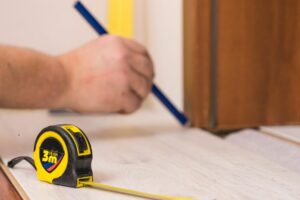How to Measure Rooms for New Flooring

When beginning a new flooring project, taking accurate measurements of the rooms or space is a key factor to ensure a successful installation. These figures will help you calculate square footage accurately, budget accordingly, and plan for your purchase in the most effective manner. These proper numbers will also help prevent running out of flooring and financial resources before the installation is complete- you need to know how much flooring material is required and how much it will cost!
Luckily, it’s easy to measure your spaces like a flooring professional. Of course, we offer our many Flooring 101 Project Resources and Floor Shopping Tips, and feel free to contact us at any point for help. In the meantime, grab your pen, paper, tape measure, and use these easy-to-follow steps for how to measure for flooring installation:
How to Measure Length & Width of a Room

Easily enough, grab your tape measure to take the length and width of the walls in the room receiving new flooring and write them down.
- Round each measurement up to the nearest inch.
- To convert the length and width measurements in terms of feet, divide the inches in each measurement by twelve and add that figure to the feet in each measurement.
- Write down these new totals, which are now the length and width measurements to use for new flooring.
With these converted measurements, multiply the room length by the room width to get the square footage of the room. Write down this figure and label it as well. If you only have one room receiving new flooring, this might be the extent of your measurements!
How to Measure Tricky Rooms for New Flooring
Many of us have rooms in the home that are not perfect squares or rectangles and can be trickier to measure for new flooring. If you have an irregularly shaped room like an L-shape or a room with an inlet, split the room into separate areas that will make taking measurements easier.
- Measure each section separately.
- Calculate the square footage of each section separately and write each down.
- Add the square footage figures together to find the total square footage of the area.
Extra Tips for Measuring Rooms

In addition to finding the square footage of the rooms receiving new flooring, here are a few valuable bonus tips that will help eliminate surprise costs when budgeting for a new project:
- Doors, Closets & Transitions – Make note of any doorways, closet spaces, and transition areas that in or adjacent to the room. Calculate each square footage and add them to your total.
- Additional Rooms – If you have more than one room receiving new flooring, calculate the square footage of each separately and add all the square footage figures together for the total amount of flooring needed.
- Accent Walls – If you are using flooring material to design an accent wall, you can use all of the steps and tips in this blog to measure walls and plan accurately as well!
How Much Extra Flooring to Purchase
Once you have the total square footage area for your new flooring project, including all rooms and considerations, it’s wise to budget for an additional 10-15% of extra flooring material. This extra flooring will cover mistakes and the plank cuts that are needed when a new floor is installed:
- Multiply your total area figure by at least 1.1 to get the extra flooring amount.
- Multiply your total area figure by 1.5 to get the extra flooring amount if your room has a trickier floorplan.
Once you arrive at your extra flooring amount, add this figure to your total area for your grand total!
When you are ready to purchase your new favorite flooring, we can help you determine how many cases or rolls you will need to cover your grand square footage total. Reach out to Flooring 101 or visit any one of our seven Flooring 101 locations and we will help move your project forward!



